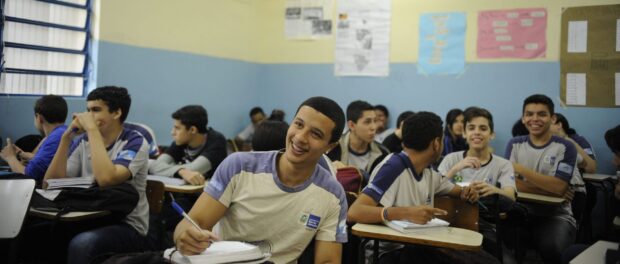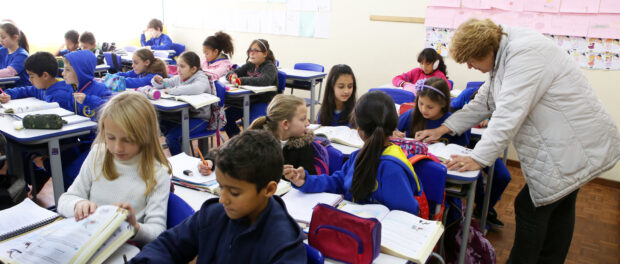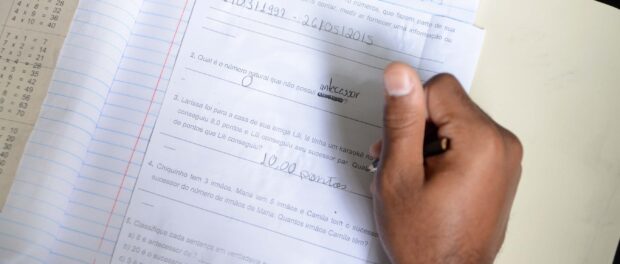
Rio de Janeiro state has one of the largest public school networks in the world, with more than 1,000 municipal schools alone. Across Brazil, public schools absorb approximately 80% of students. Places in public schools are allocated based on location by a committee of city and state secretariats, and unlike in the United States, analyses suggest that “there is no evidence that public schooling is an important dimension in neighborhood choice” for cariocas.
Education follows the same schooling stages in Rio as elsewhere in Brazil, beginning with daycare for infants aged 2-4. Preschool is for children between 4 and 6 years old, followed by Ensino Fundamental I and II (Fundamental Instruction), attended by students aged 6-14. Ensino Médio (high school), is aimed at those between 15 and 17, but in reality has a student body composed of pupils mostly aged between 15 and 19. At all stages, school days typically last between 3 and 4 hours, primarily due to a lack of space. While daycare is optional, every stage from preschool onwards is mandatory by federal law as of 2016.

There is no strict national curriculum in Brazil; states are instead given national guidelines for what students should learn at each stage but are expected to incorporate “regional and local characteristics.” At all stages of learning, the primary subjects are Portuguese language, mathematics and science, as well as “knowledge of the country’s social and political reality,” arts and physical education. The absence of a national syllabus has occasionally caused problems in testing: in one national exam students were asked to describe a jackfruit, which proved problematic for those outside of Rio de Janeiro, the main Brazilian state where jackfruit grows.
The federal safety net income subsidy program Bolsa Família has significantly boosted school attendance rates across Brazil, but the quality of education means that the country still lags far behind others in overall global rankings; Brazil ranked in the 54th position of 65 countries measured by the OECD in 2011. Despite quality of education being one of the main points in Brazil’s 2014 National Educational Plan (PNE) and a 121% increase in investment in public education between 2000 and 2008 alone, as of yet there have been no signs of improvement. The Institute for Research and Administration in Education (IPAE) recommended reforms, which include lengthening the school day, investing in technology, providing job stability for teachers, increasing efficiency in school management, and proper policy implementation from federal to municipal to individual school levels.
What are the main difficulties facing public education in Rio de Janeiro?
Quality of education in Rio was a significant factor in the student protests that began in March 2016, and which saw students occupying public high schools to demand higher standards of education, access to school resources and facilities, and better learning conditions, among other factors. Serious investment is needed to maintain Rio’s public schools, many of which are housed in crumbling, state-owned buildings: a 2011 survey carried out by Rio’s Municipal Education Secretariat found that 62% of municipal school infrastructure was “satisfactory, poor or very poor.” No investments have been made despite the 2011 research, and between 2014 and 2015 Rio state also saw a 72% fall in investment in infrastructure and maintenance. Nor were any new state school units built by Rio’s state government during this period, despite a promise made before the 2014 World Cup for 177 new public schools by 2015.
The shortcomings of the public school system are most obvious among students aged 15 and over, who should be beginning high school. By the time students in Rio de Janeiro finish Ensino Fundamental II, 23.5% are two years or more behind. Rio de Janeiro state has the highest rate of delayed graduation in Brazil: 27.4% of private high school students and 51.6% of public high school students graduate late, implying repeated school years. In research commissioned in 2010, low high school attendance rates were attributed to a stronger economy attracting young people to join the workforce, a lack of interest by students, poor organization of disciplines in school, urban violence, teenage pregnancy, and a lack of opportunity to pursue higher education.
How do different areas of the city compare?
Socioeconomic differences between various areas of the city primarily present themselves through literacy rates. Approximately 2.8% of citizens aged 15 or older in the city of Rio are illiterate, and in Tijuca, Méier and across the South Zone, adult illiteracy is as low as 2%. However, in Santa Cruz (West Zone), Ramos and Inhaúma (North Zone) this number is almost double, with adult illiteracy reaching 4.9%, 4.2% and 4.1% respectively.
Attendance rates are another area that demonstrate disparities within Rio. According to the city’s Regional Planning department, high school attendance drops “in areas of lower income,” such as Penha where only 80.4% of those aged 15-17 were studying in 2010. Meanwhile in Tijuca and Madureira—where the average income is significantly higher than in some other areas in the city—91% of high school age students were attending school.

Black and mixed race students had disproportionately low pre- and high school attendance rates as well as high functional illiteracy and grade repetition rates across Rio state. Daycare attendance rates were lower among black and mixed race children, as were preschool and high school attendance rates prior to the introduction of current legislation. Literacy rates reflect this: 4% of black preschoolers were illiterate compared to 1.8% of white preschoolers. Among 8 and 9 year-olds, 8% of black pupils and 4% of white pupils were illiterate. And among high school students this was 2.2% of blacks and 1.4% of whites. The city of Rio’s data also show “blacks consistently registering higher distortion rates than white students,” referring to rates at which students are studying at a lower level than intended for their age, usually due to grade repetition.
Maps published in late 2015 show that Rio’s black and mixed race citizens live predominantly in lower-income, more marginalized areas such as Ramos and Santa Cruz, while the South Zone and Tijuca are largely populated by whites. Education across the city maps out the socioeconomic and racial inequalities present in Rio de Janeiro today.
The most up-to-date information available on literacy rates, spatial and socioeconomic disparities in Rio de Janeiro come from a study conducted by Rio’s city government, which can be found here. This is partially based on information from the 2010 National Census, in addition to more recent research.
